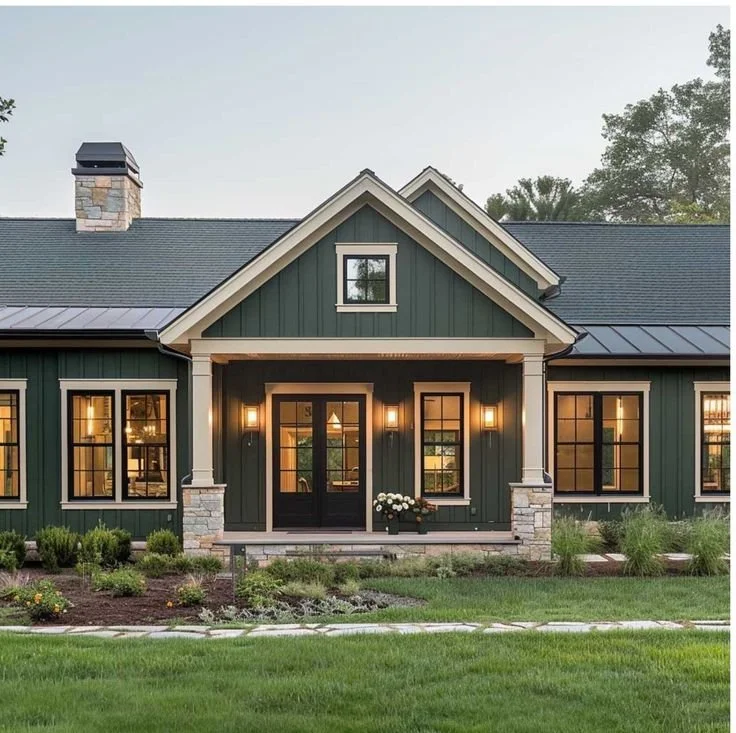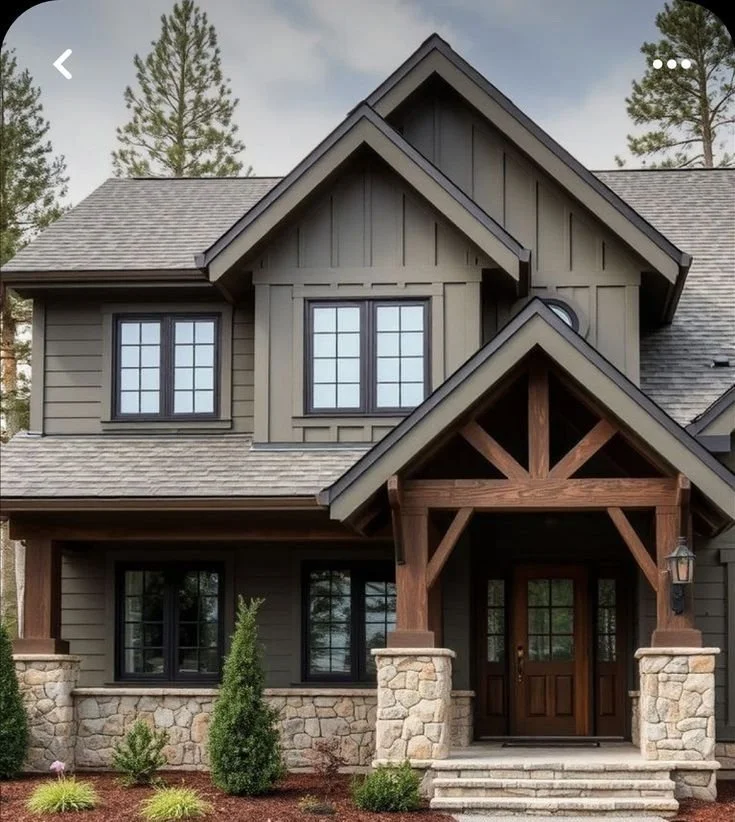What Makes a Modern Craftsman? A Closer Look at Modern Craftsman Exteriors
Hey friends!
It's been way too long since my last post, but I'm diving back in with a topic that’s been on my mind for a while now: how do you modernize a Craftsman façade without losing that Craftsman charm?
Before we jump into ideas, it’s important to get clear on what makes a Craftsman a Craftsman. Once we’ve nailed down those signature elements, we can talk about how to tweak and modernize them—while still keeping that cozy, character-filled vibe these homes are known for.
If you’ve seen my other posts on Craftsman architecture, (you can check them out here & here) you’re probably familiar with the look:
A welcoming front porch
Tapered columns with chunky bases
Low-pitched roofs with dormers and front-facing gables
Brackets under the eaves (sometimes just for the aesthetic, sometimes functional)
A mix of siding—like wood shakes, stone, or brick
Warm, earthy colors and natural materials
Here are a few of my favorite examples from a tour I did in Edmonton a little over a year ago:
As you can see, all of these signature elements work together to create a home that feels grounded, charming, and full of personality. So how you can give that classic Craftsman look a modern twist—without losing what makes it special?
The more I think about it, the more I believe it comes down to one thing: balance.
Let’s use this house as an example:
The overall shape, size, and rooflines stick pretty closely to traditional Craftsman style. You’ve got those classic front porch columns with chunky stone bases and shake siding on the veranda roof—both clear nods to the original look.
So what makes it feel modern? In this case the colours and materials are pretty impactful. We have a metal roof over the veranda, a moody, grey/black monochrome palette, and black-framed windows. But I think what’s really creating the clean modern look is the simple approach to detailing and holding back on heavy ornamentation that gives it that fresh, contemporary vibe.
Here’s why:
This Craftsman-style home shares a very similar color palette with the previous example, but if you look closely at the second floor, there’s a bit more variation in materials. I can spot at least two different styles of shake siding, along with a small section of board and batten. Each material is separated by horizontal trim, which adds layers of visual interest. The two larger windows are topped with small accent roofs supported by arched brackets, while additional brackets are dispersed along the various rooflines. So even though the color scheme is nearly identical to the last home, all of this extra detailing gives it a more traditional, classic Craftsman feel.
Moving onto the next house below, which has a steep front-facing gable that is more reminiscent of a Farmhouse. The designer or architect of this home also took a more daring approach with the front porch, enclosing it with simple, boxy frame as opposed to heavy columns. Despite the pivot away from the traditional Craftsman build form and typical Craftsman veranda, this house still has a cozy charm that I think has been preserved through the application of shake siding, the warm, earthy tones, and a clear sense of welcome as you approach the front porch.
In contrast, the next home takes almost the opposite approach. Instead of shake siding, it uses board and batten—something you’ll often see on modern Farmhouse-style homes. Even with that swap, it still feels very much like a modern Craftsman, thanks to a few key details: chunky porch posts, a welcoming veranda, low-pitched rooflines, and lots of decorative brackets throughout.
It’s also worth noting how color plays a role in shaping the home’s identity. Had the exterior been finished in more muted, earthy tones, the overall feel might have leaned more traditional. Instead, the crisp white, soft grey, and contrasting black accents give it a clean, modern edge—adding a contemporary layer to a largely traditional façade.
The last thing I want to talk about is the role of shake siding in Craftsman-style homes. At first glance, the example above might make it seem like shakes aren’t all that important when it comes to creating a modern Craftsman look. You might even think that leaving them out is an easy way to instantly modernize the elevation. But if you take a closer look, the home’s overall form still sticks closely to traditional Craftsman design. So in this case specifically, skipping the shakes didn’t take away from the style—it actually helps give it a cleaner, more modern edge while still holding onto its Craftsman roots.
Now, if you look at the two examples below, both homes have also omitted the shakes in lieu of board & batten—but something feels different. Even though they include hallmark Craftsman details like sturdy columns with stone bases, welcoming front porches, and warm, earthy colors, they still lean more Farmhouse than Craftsman. That shift, I think, comes down to the overall structure—the build form itself doesn’t reflect traditional Craftsman proportions. Instead, it feels more in line with today’s modern Farmhouse style.
So here’s the takeaway: if you’re trying to pull off a modern Craftsman look without shakes, the rest of the home needs to do a lot of the heavy lifting. You still need that Craftsman shape, roofline, and detailing to carry the style. Otherwise, without the shakes, the design starts to drift into Farmhouse territory with just a hint of Craftsman influence.
Finally, I just want to conclude by saying that the goal of this post wasn’t to create a set of hard rules or a definitive guide. Honestly, it’s more about helping me work through a design question I’ve been sitting with for a while. If your take on residential architecture looks a little different, that’s totally okay. I genuinely believe our homes should reflect who we are—our tastes, our values, and how we want to live. Hopefully, these thoughts gave you a bit of perspective and helped you get a little closer to an answer that feels true to you.
BY EMILY RADKIE










